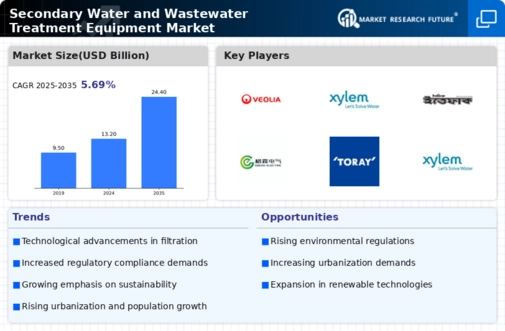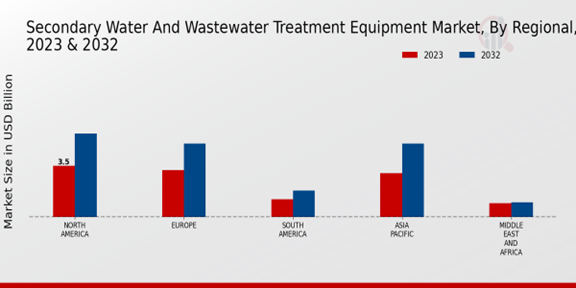Rising Industrialization
The surge in industrial activities globally is a key driver for the Global Secondary Water and Wastewater Treatment Equipment Market Industry. Industries such as manufacturing, pharmaceuticals, and food processing generate substantial amounts of wastewater, necessitating effective treatment solutions. As countries industrialize, the demand for wastewater treatment equipment increases to mitigate environmental impacts and comply with regulations. For instance, in emerging economies, the establishment of industrial parks often includes integrated wastewater treatment facilities. This trend underscores the importance of investing in treatment technologies, contributing to the market's anticipated growth trajectory.
Increasing Water Scarcity
The Global Secondary Water and Wastewater Treatment Equipment Market Industry is experiencing heightened demand due to increasing water scarcity across various regions. As populations grow and urban areas expand, the pressure on freshwater resources intensifies. For instance, regions like the Middle East and North Africa face severe water shortages, prompting investments in wastewater treatment technologies. This trend is expected to drive the market, as municipalities and industries seek efficient solutions to recycle and reuse water. The industry's growth is projected to align with the global market's expansion, which is anticipated to reach 13.2 USD Billion in 2024.
Market Growth Projections
The Global Secondary Water and Wastewater Treatment Equipment Market Industry is projected to experience substantial growth in the coming years. With a market value expected to reach 13.2 USD Billion in 2024 and further expand to 24.4 USD Billion by 2035, the industry is on a promising trajectory. This growth is underpinned by a compound annual growth rate (CAGR) of 5.69% from 2025 to 2035. Such projections indicate a robust demand for innovative treatment solutions, driven by factors such as increasing water scarcity, regulatory pressures, and technological advancements. The market's expansion reflects the critical role of wastewater treatment in sustainable water management.
Technological Advancements
Innovations in treatment technologies are significantly influencing the Global Secondary Water and Wastewater Treatment Equipment Market Industry. The development of advanced filtration systems, membrane bioreactors, and smart monitoring solutions enhances the efficiency and effectiveness of wastewater treatment processes. For instance, the integration of IoT technologies allows for real-time monitoring and optimization of treatment operations. These advancements not only improve treatment outcomes but also reduce operational costs, making them attractive to municipalities and industries alike. As technology continues to evolve, the market is poised for growth, with a projected CAGR of 5.69% from 2025 to 2035.
Regulatory Compliance and Standards
Stringent environmental regulations are propelling the Global Secondary Water and Wastewater Treatment Equipment Market Industry forward. Governments worldwide are implementing stricter guidelines to ensure that wastewater is treated effectively before being discharged into natural water bodies. For example, the European Union's Water Framework Directive mandates high standards for water quality, compelling industries to adopt advanced treatment technologies. This regulatory landscape not only fosters innovation but also creates a robust market for treatment equipment. As compliance becomes increasingly critical, the market is expected to grow, with projections indicating a value of 24.4 USD Billion by 2035.
Public Awareness and Sustainability Initiatives
Growing public awareness regarding environmental sustainability is shaping the Global Secondary Water and Wastewater Treatment Equipment Market Industry. Citizens are increasingly advocating for responsible water management practices and the adoption of sustainable technologies. This shift in consumer behavior is prompting governments and industries to prioritize wastewater treatment solutions that minimize environmental impact. Initiatives aimed at promoting water conservation and recycling are gaining traction, further driving the demand for advanced treatment equipment. As sustainability becomes a focal point in policy-making and corporate strategies, the market is likely to see continued growth, reflecting changing societal values.


















Leave a Comment